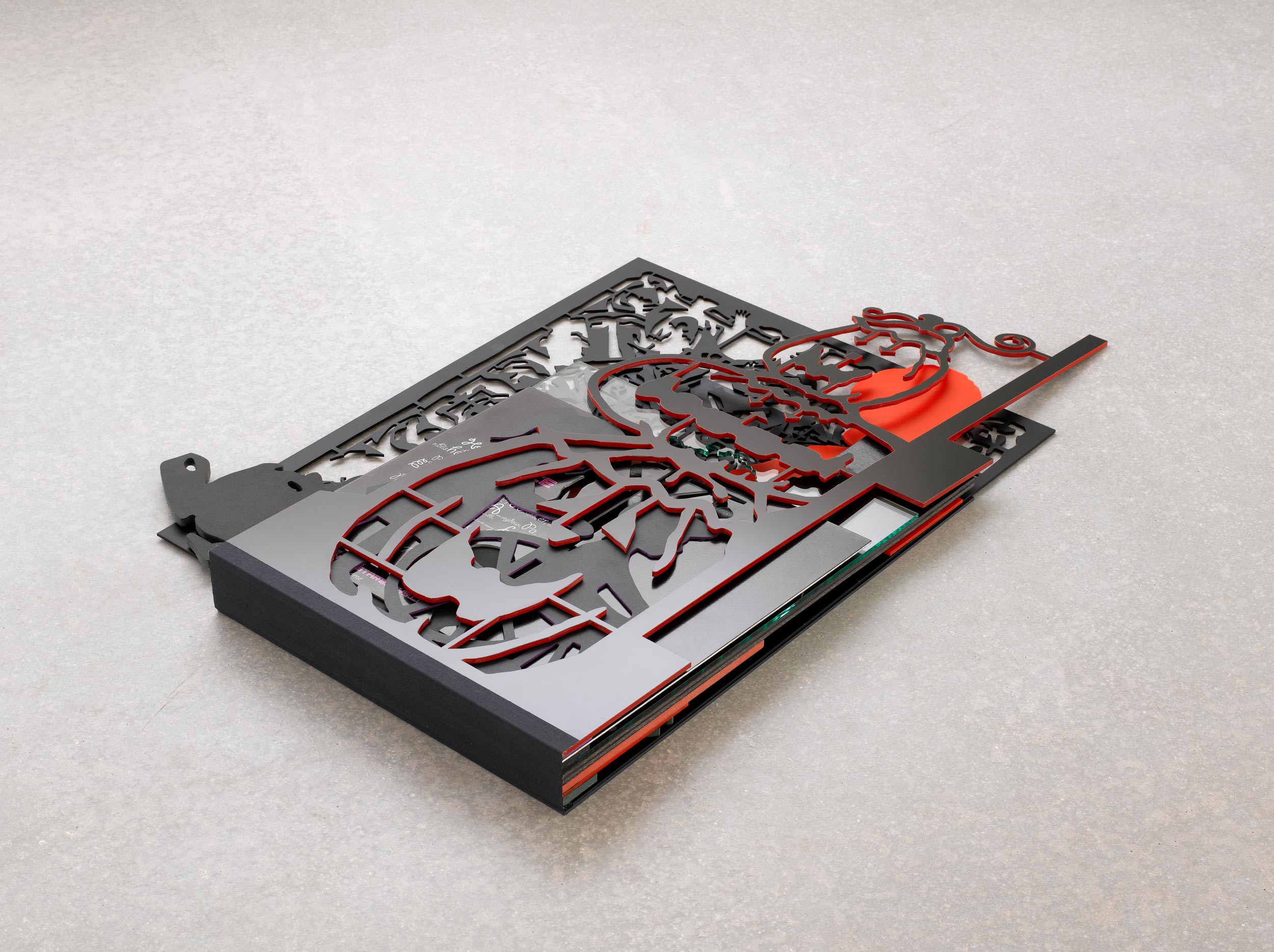2008
6 copies
Signed and numbered
6 copies
Signed and numbered
Open dimensions:
59×10×180 cm
23.2×3.9×79.8 in.
59×10×180 cm
23.2×3.9×79.8 in.
11 plates
Laser-cut materials
Laser-cut materials








When asked to design a publication, Rehberger chose to make the kind of stand-up publication that the smallest of children play with. The rigid and yet “pages” of “Holy Silence” are constructed so as to fit something like the elements in Charles and Ray Eames’ 1952 House of Cards, a toy that is also a piece of complex engineering. Rehberger’s materials range from anodized aluminum, acrylic plexiglass, MDF, and plastic to plywood, resin, rubber, and copper. Realization of the work involved both virtual and handmade models that explored all possible geometric and technical configurations. The issues that pervade Rehberger’s thinking are neatly crystallized in his publications. Fusion of roles such as artist, author, producer, and writer, as well as an inversion of order and the dissolution of “normal” functions, achieve their masterly synthesis in Holy Silence.
The anecdotal nature of the medium acquires deeper significance when the nature of the images is studied. Far from the idyllic climate of Christmas, Rehberger deconstructs childhood in visions of hangings, grimacing pumpkins, and cartoon-like babies, with a sinister quality, analogous to artist Maurizio Cattelan’s de-sanctified visions of youth. Rehberger’s play with the work of his colleagues, subtle reference to the 1994 house of Jorge Pardo, or the material virtuosity of artists such as Reinhard Mucha, add other layers to the piece. Holy Silence is testimony to the the true artist’s ability to take any commission, from salt cellar to skyscraper, and turn it into a timeless work of art.
Closed dimensions: 87×59×10 cm - 34.3×23.2×3.9 in.
Tobias Rehberger (b. 1966) has created work as disparate as lighting arrangements, furniture, gardens, graphic design, film, and sculptural installations that delight with their zip and flair. Reveling in his skills as a designer of print material and sculptural form, Rehberger joins colleagues Liam Gillick, Jorge Pardo, Pae White, Jason Rhodes, and others, in riffing off textiles patterns, record covers, and memorabilia of the 60s and 70s.
The result is a dizzying assemblage of forms and patterns which nonetheless rise above decor to create the kind of universe only great artists are capable of. Rehberger's position on any central meaning to his work has always been elliptical. In designing high tech objects that are then produced artisanally, or creating portraits using a floral bouquet, Rehberger elides distinctions between art and craft, and stretches the modes that art can assume.
The anecdotal nature of the medium acquires deeper significance when the nature of the images is studied. Far from the idyllic climate of Christmas, Rehberger deconstructs childhood in visions of hangings, grimacing pumpkins, and cartoon-like babies, with a sinister quality, analogous to artist Maurizio Cattelan’s de-sanctified visions of youth. Rehberger’s play with the work of his colleagues, subtle reference to the 1994 house of Jorge Pardo, or the material virtuosity of artists such as Reinhard Mucha, add other layers to the piece. Holy Silence is testimony to the the true artist’s ability to take any commission, from salt cellar to skyscraper, and turn it into a timeless work of art.
Closed dimensions: 87×59×10 cm - 34.3×23.2×3.9 in.
Tobias Rehberger (b. 1966) has created work as disparate as lighting arrangements, furniture, gardens, graphic design, film, and sculptural installations that delight with their zip and flair. Reveling in his skills as a designer of print material and sculptural form, Rehberger joins colleagues Liam Gillick, Jorge Pardo, Pae White, Jason Rhodes, and others, in riffing off textiles patterns, record covers, and memorabilia of the 60s and 70s.
The result is a dizzying assemblage of forms and patterns which nonetheless rise above decor to create the kind of universe only great artists are capable of. Rehberger's position on any central meaning to his work has always been elliptical. In designing high tech objects that are then produced artisanally, or creating portraits using a floral bouquet, Rehberger elides distinctions between art and craft, and stretches the modes that art can assume.